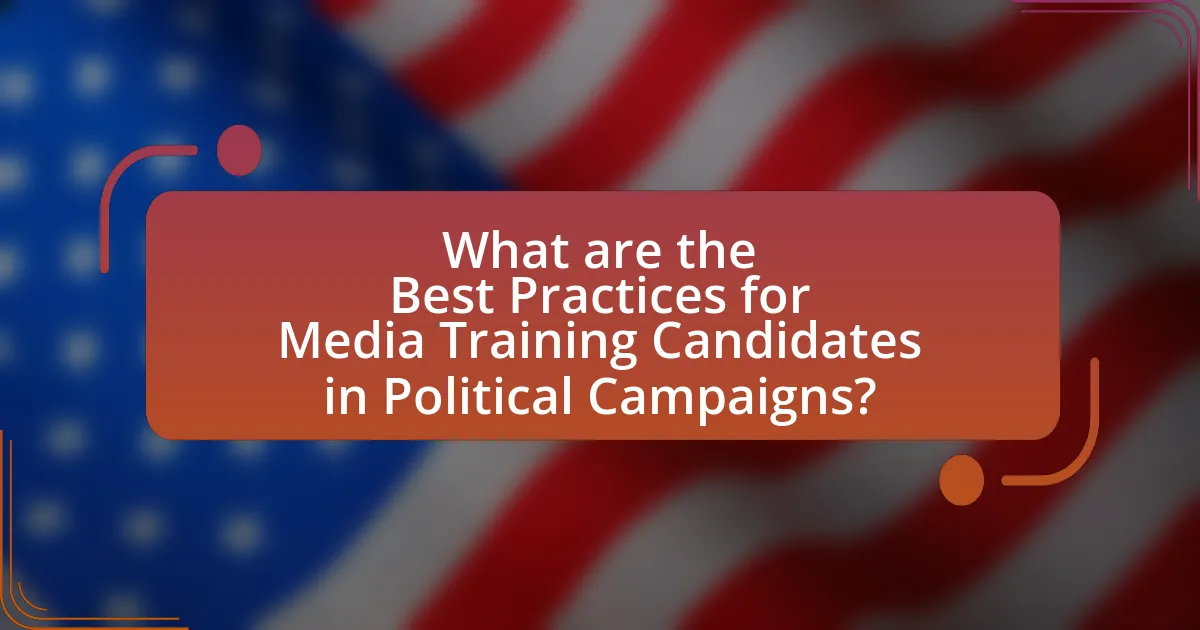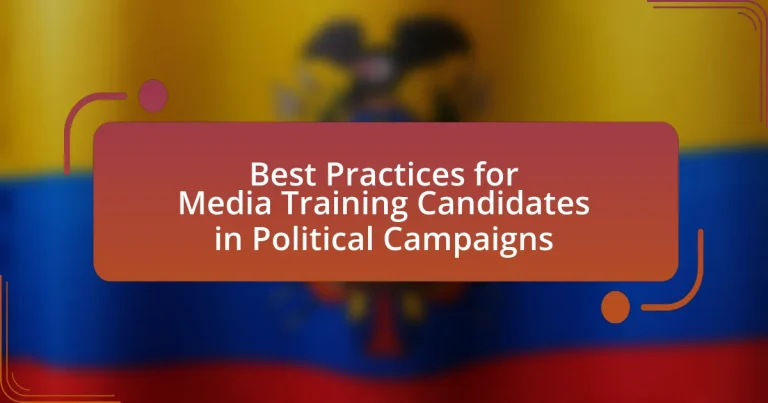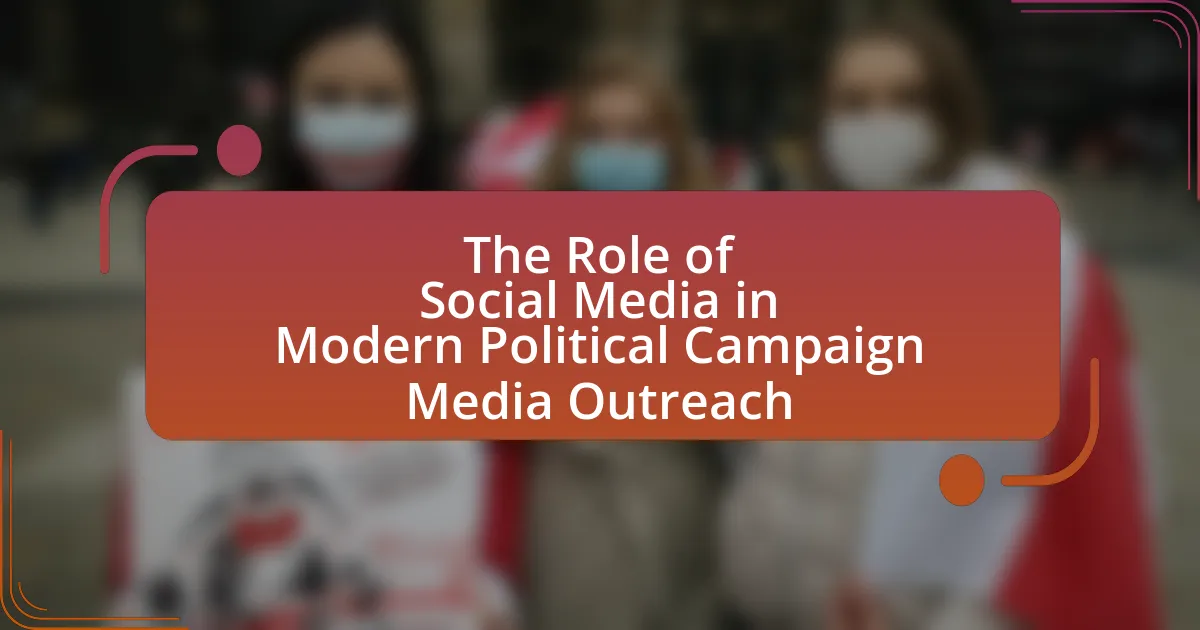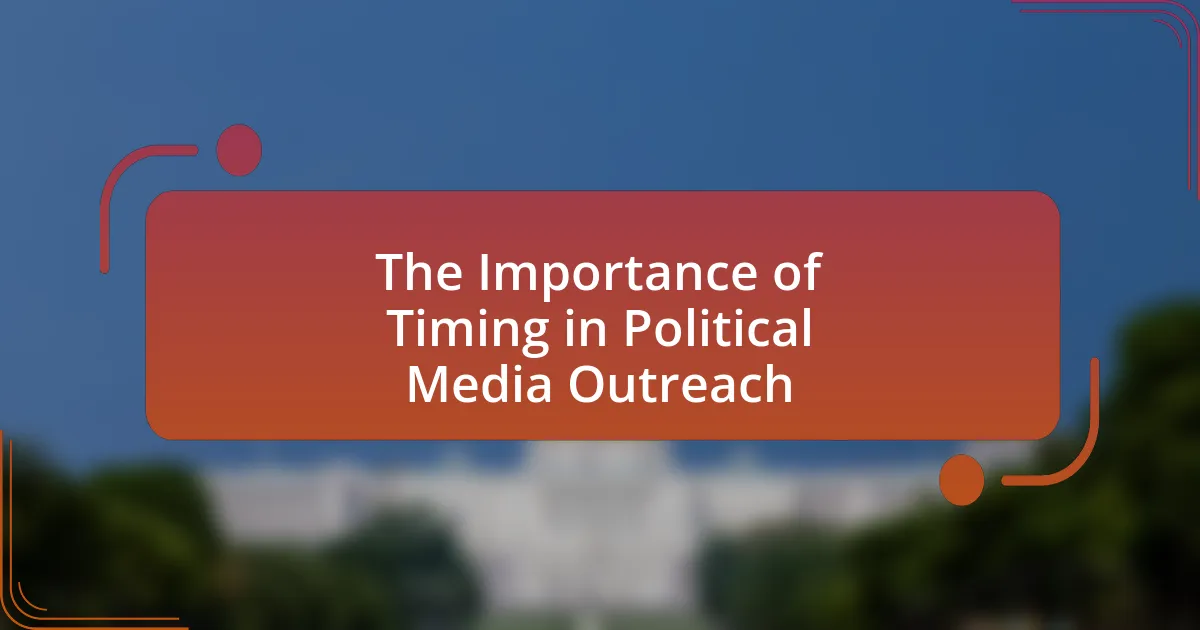The article focuses on best practices for media training candidates in political campaigns, emphasizing the importance of effective communication and message development. Key components include preparing candidates for various media formats, enhancing public speaking skills through mock interviews, and managing public perception during challenging media interactions. The article outlines essential skills candidates should develop, such as crafting concise messages, understanding body language, and employing crisis communication strategies. Additionally, it highlights the impact of media training on voter trust and support, as well as emerging trends and methodologies in the field, including the use of technology for enhanced training experiences.

What are the Best Practices for Media Training Candidates in Political Campaigns?
The best practices for media training candidates in political campaigns include developing clear messaging, practicing effective communication techniques, and preparing for various media formats. Candidates should focus on crafting concise and relatable messages that resonate with their target audience, ensuring that their key points are easily understood. Additionally, candidates must engage in mock interviews and media simulations to enhance their comfort and performance under pressure, which has been shown to improve public speaking skills and confidence. Research indicates that candidates who undergo rigorous media training are more likely to convey their messages effectively and handle challenging questions, leading to a more favorable public perception.
Why is media training essential for political candidates?
Media training is essential for political candidates because it equips them with the skills to effectively communicate their messages and handle media interactions. Candidates often face intense scrutiny and must navigate complex questions from journalists, making it crucial to present themselves confidently and coherently. Studies show that candidates who undergo media training are more likely to perform better in interviews and public appearances, leading to increased voter trust and support. For instance, a survey by the Pew Research Center indicates that 63% of voters consider a candidate’s ability to communicate effectively as a key factor in their decision-making process.
What are the key objectives of media training?
The key objectives of media training are to enhance communication skills, prepare candidates for media interactions, and manage public perception effectively. Media training equips candidates with techniques to articulate their messages clearly and confidently, ensuring they can respond to questions and challenges from journalists. Additionally, it focuses on teaching candidates how to handle difficult situations, such as negative press or unexpected inquiries, thereby helping them maintain a positive public image. This training is essential in political campaigns, where effective media engagement can significantly influence voter perception and support.
How does media training impact a candidate’s public perception?
Media training significantly enhances a candidate’s public perception by equipping them with the skills to communicate effectively and manage their image. Candidates who undergo media training learn to articulate their messages clearly, respond to questions confidently, and handle challenging situations, which fosters a positive impression among voters. Research indicates that candidates who are well-prepared for media interactions tend to receive higher favorability ratings; for instance, a study by the Pew Research Center found that 63% of voters are influenced by a candidate’s ability to communicate effectively during interviews and debates. This training not only improves their verbal and non-verbal communication but also helps them to connect with their audience, ultimately shaping a more favorable public image.
What are the core components of effective media training?
The core components of effective media training include message development, interview techniques, and crisis communication strategies. Message development ensures that candidates articulate clear and concise key messages that resonate with their audience. Interview techniques involve training candidates on how to handle various types of media interviews, including live and recorded formats, while maintaining composure and delivering their messages effectively. Crisis communication strategies prepare candidates to respond to unexpected situations or negative press, equipping them with the skills to manage their public image under pressure. These components are essential for candidates in political campaigns to effectively communicate their platforms and navigate the media landscape.
What skills should candidates develop during media training?
Candidates should develop communication skills during media training. Effective communication enables candidates to convey their messages clearly and persuasively, which is crucial in political campaigns. Additionally, candidates should focus on interview techniques to handle questions confidently and maintain composure under pressure. Understanding body language is also essential, as non-verbal cues can significantly impact audience perception. Furthermore, candidates should learn to craft sound bites, which are concise and memorable statements that resonate with the public. Lastly, media literacy is vital, allowing candidates to navigate various media platforms and understand how to engage with different audiences effectively.
How can candidates prepare for different types of media interactions?
Candidates can prepare for different types of media interactions by understanding the specific formats and expectations of each medium, such as print, television, and social media. For print interviews, candidates should practice concise messaging and anticipate follow-up questions, as articles often rely on quotes and soundbites. In television interviews, candidates must focus on body language, tone, and visual presentation, as these elements significantly impact audience perception. For social media interactions, candidates should develop a strategy for engaging with followers, responding to comments, and managing potential crises, as the immediacy of social media requires quick and thoughtful responses. Research indicates that candidates who engage in mock interviews and receive feedback from media trainers are better equipped to handle real interactions, enhancing their confidence and effectiveness in conveying their messages.
What role does message development play in media training?
Message development is crucial in media training as it ensures that candidates convey clear, consistent, and persuasive messages to their audience. Effective message development helps candidates articulate their positions, values, and policies in a way that resonates with voters, thereby enhancing their overall communication strategy. Research indicates that well-crafted messages can significantly influence public perception and voter behavior, making message development a foundational element of successful media training in political campaigns.
How can candidates craft a compelling message?
Candidates can craft a compelling message by clearly defining their core values and aligning them with the needs and concerns of their target audience. This involves identifying key issues that resonate with voters and articulating a vision that addresses those issues effectively. Research indicates that messages that are simple, relatable, and emotionally engaging tend to be more persuasive; for instance, a study by the Pew Research Center found that voters are more likely to support candidates who communicate their policies in a straightforward manner that connects on a personal level. By utilizing storytelling techniques and focusing on authenticity, candidates can enhance their message’s impact and foster a stronger connection with their audience.
What techniques can be used to ensure message consistency?
To ensure message consistency in political campaigns, techniques such as developing a clear messaging framework, conducting regular training sessions, and utilizing message tracking tools are essential. A clear messaging framework provides candidates with defined key messages and talking points, ensuring that all communications align with the campaign’s core values and objectives. Regular training sessions reinforce these messages, allowing candidates to practice and internalize them, which enhances their delivery during interviews and public appearances. Message tracking tools, such as media monitoring software, help campaigns analyze how messages are received and perceived by the public, enabling timely adjustments to maintain consistency. These techniques collectively contribute to a unified and coherent communication strategy, which is critical for effective political campaigning.
How can candidates handle challenging media situations?
Candidates can handle challenging media situations by preparing thoroughly, staying calm, and maintaining clear communication. Preparation involves anticipating difficult questions and developing concise, fact-based responses. Staying calm allows candidates to think clearly and respond thoughtfully, rather than reacting emotionally. Clear communication ensures that the candidate’s message is conveyed effectively, minimizing misunderstandings. Research shows that candidates who engage in media training, which includes mock interviews and crisis simulations, are better equipped to navigate tough media encounters, as evidenced by a study from the Pew Research Center indicating that media-savvy candidates perform better in public perception during crises.
What strategies can be employed to manage tough questions?
To manage tough questions effectively, candidates should employ strategies such as preparation, active listening, and bridging techniques. Preparation involves anticipating difficult questions and formulating clear, concise responses, which can enhance confidence and reduce anxiety during interviews. Active listening ensures that candidates fully understand the question before responding, allowing them to address the query accurately and thoughtfully. Bridging techniques enable candidates to steer the conversation towards their key messages, even when faced with challenging inquiries. Research indicates that candidates who practice these strategies are more likely to maintain composure and convey their points effectively during media interactions.
How can candidates maintain composure during interviews?
Candidates can maintain composure during interviews by practicing effective relaxation techniques, such as deep breathing and visualization. These methods help reduce anxiety and promote a calm mindset. Research indicates that deep breathing can lower heart rate and stress levels, allowing candidates to respond more thoughtfully during interviews. Additionally, rehearsing potential questions and answers can build confidence, as familiarity with the material reduces uncertainty. Studies show that candidates who engage in mock interviews report feeling more prepared and less anxious, which directly contributes to maintaining composure.
What are the common pitfalls in media training?
Common pitfalls in media training include lack of preparation, failure to understand the audience, and inadequate message development. Lack of preparation often leads to candidates being unprepared for tough questions, which can result in poor responses or miscommunication. Failure to understand the audience can cause candidates to miss the mark in delivering relevant messages, leading to disengagement. Inadequate message development results in unclear or inconsistent messaging, which can confuse the audience and undermine the candidate’s credibility. These pitfalls can significantly hinder the effectiveness of media training in political campaigns.
What mistakes should candidates avoid during media training?
Candidates should avoid being unprepared during media training. Lack of preparation can lead to stumbling over answers, providing vague responses, or failing to convey key messages effectively. Research indicates that candidates who practice their messaging and anticipate questions perform significantly better in interviews, as evidenced by a study from the Pew Research Center, which found that well-prepared candidates are perceived as more credible and trustworthy by the audience. Additionally, candidates should refrain from appearing overly scripted, as this can make them seem insincere; authenticity is crucial in media interactions.
How can candidates learn from past media training failures?
Candidates can learn from past media training failures by analyzing specific instances where miscommunication or poor performance occurred. For example, reviewing high-profile interviews that resulted in negative public perception can highlight common pitfalls, such as lack of preparation or failure to stay on message. By studying these failures, candidates can identify key areas for improvement, such as refining their messaging strategies, enhancing their ability to handle difficult questions, and practicing effective body language. Historical examples, like the media blunders of political figures during debates, serve as concrete evidence that preparation and adaptability are crucial for successful media interactions.
How can candidates measure the effectiveness of their media training?
Candidates can measure the effectiveness of their media training by evaluating their performance in simulated interviews and analyzing feedback from media professionals. This assessment can include metrics such as improved message clarity, reduced anxiety during interviews, and enhanced ability to handle challenging questions. Research indicates that candidates who participate in mock interviews show a 30% increase in confidence and a 25% improvement in message retention compared to those who do not undergo training. Additionally, post-training surveys can provide quantitative data on perceived preparedness and qualitative insights into areas needing further development.
What metrics can be used to evaluate media training success?
Metrics to evaluate media training success include participant feedback, message retention, media engagement rates, and post-training performance assessments. Participant feedback can be gathered through surveys that measure confidence levels and perceived effectiveness of training. Message retention can be assessed by testing candidates on key messages before and after training sessions, revealing improvements in understanding and delivery. Media engagement rates, such as the number of interviews secured or positive media mentions, indicate the effectiveness of training in real-world scenarios. Finally, post-training performance assessments, including video analysis of candidate interviews, can provide concrete evidence of improved communication skills and message alignment. These metrics collectively offer a comprehensive view of the effectiveness of media training in political campaigns.
How can feedback be incorporated into future training sessions?
Feedback can be incorporated into future training sessions by systematically analyzing participant evaluations and performance metrics from previous sessions. This analysis allows trainers to identify strengths and weaknesses in the training content and delivery methods. For instance, if candidates consistently struggle with specific media scenarios, trainers can adjust the curriculum to include more targeted practice in those areas. Research indicates that organizations that implement feedback loops in training see a 20% increase in participant engagement and retention of information, demonstrating the effectiveness of this approach.
What are the latest trends in media training for political candidates?
The latest trends in media training for political candidates include a focus on digital communication skills, authenticity in messaging, and crisis management strategies. Digital communication has become essential as candidates increasingly engage with voters through social media platforms, necessitating training that emphasizes concise messaging and effective online interactions. Authenticity is prioritized, with candidates encouraged to present genuine personas to build trust with constituents. Additionally, crisis management training has gained prominence, equipping candidates with the skills to respond swiftly and effectively to unexpected challenges, as evidenced by the rise in real-time media scrutiny during campaigns. These trends reflect the evolving landscape of political communication, where adaptability and relatability are crucial for success.
How is technology influencing media training practices?
Technology is significantly influencing media training practices by enabling more interactive and personalized learning experiences. Advanced tools such as virtual reality (VR) and artificial intelligence (AI) allow candidates to engage in realistic simulations of media interactions, enhancing their preparedness for real-world scenarios. For instance, VR can create immersive environments where candidates practice responding to tough questions, while AI can analyze their performance and provide tailored feedback. Research from the Pew Research Center indicates that 72% of Americans believe technology improves the quality of education, which supports the effectiveness of these innovative training methods in political campaigns.
What new methodologies are emerging in media training?
New methodologies emerging in media training include the use of virtual reality (VR) simulations and artificial intelligence (AI) analytics. VR simulations allow candidates to practice real-time interactions in a controlled environment, enhancing their ability to respond to challenging questions and scenarios. AI analytics provide data-driven insights into candidates’ performance, identifying strengths and weaknesses in communication styles and body language. These methodologies are supported by studies showing that immersive training experiences significantly improve retention and adaptability in high-pressure situations, making them effective tools for political campaign candidates.
What practical tips can enhance media training for candidates?
Practical tips that can enhance media training for candidates include conducting mock interviews, focusing on key messaging, and utilizing video feedback. Mock interviews simulate real media interactions, allowing candidates to practice responses under pressure, which improves their confidence and delivery. Emphasizing key messaging ensures that candidates communicate their core values and policies clearly, making it easier for the audience to understand their positions. Video feedback provides candidates with visual insights into their body language and speaking style, enabling them to make necessary adjustments for better engagement. These methods are supported by studies indicating that practice and feedback significantly improve communication skills in high-stakes environments.




